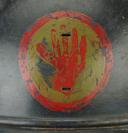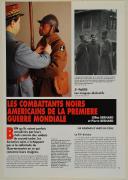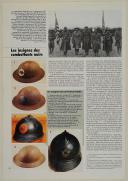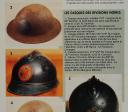
WW1 US FRENCH STEEL ADRIAN HELMET 371st and 372nd infantry regiment AEF.
Sold out
WW1 US FRENCH STEEL ADRIAN HELMET 371st and 372nd infantry regiment AEF.
With US banknote dated November 11, 1918. Afro-American red-hand division memorabilia.
Only US troops carried this type of helmet with painted badges. French troops carried only helmets with the metal grenade on the front; painted badges were not authorized.
Steel helmet with a rounded, slightly oval bowl, a peak and a neck. Minor damage to this M15 Adrian steel helmet; a few minor scratches, dents on the bowl. Hand painted badge on the front representing a red hand (47mm x32mm), ochre background, red border (6mm).
Second model liner. Chinstrap is missing.
Together with an US Silver dollar banknote with French writing “A Montreux-Vieux 11- 9bre- 1918 /Souvenir américain”: “By Montreux-Vieux. November 11, 1918 American souvenir “. Montreux-Vieux is a small town in the east of France (Alsace) near Belfort (20 km: about 12mi.).
The helmet for sale today was presented in the “Militaria magazine” issue number 129, page 33: ‘The American Black troops in WWI’ by Gilles Bernard and Pierre Besnard.
The 371st and 372nd US infantry regiments (colored troops) were a part of the 93rd French Infantry division from June to November 1918.
The 157th French Division to which they were attached became known as the “Red Hand Division” under the command of French General Mariano Goybet. Enlisted members (African American) of the 371st earned 12 American Distinguished Service Crosses, and 89 French Croix de Guerre. The 371st fought consistently on the front lines during WWI and consistently drove back the German lines. Corporal Freddie Stowers 1896-9/28/1918 Medal of Honor was a member of the U.S. 371st Infantry Regiment, 93rd US I.D. MoH.
French General Mariano Goybet was awarded the US Distinguished Service Medal.
400 000 African American served in the US Army during the war. Out of these 400 000 troops, 100 000 were sent to France, among which the eight regiments of the 92nd and 93rd US divisions, which represent about 20 000 soldiers. The others served in the Supply Services.
According to E.J. Scott in “American Negro in the World War”:
Under a staff of French officer instructors and interpreters the 371st Infantry was reorganized on the French plan, soon after its arrival in France (April 23, 1918), with 194 men to the company and three machine gun companies to the regiment instead of one as on the American plan. All the American equipment was turned in, and the men were given the French rifles, bayonets, helmets, packs, and other equipment of the French soldier. Only the American khaki uniform remained. After a few weeks' instruction in this new equipment and in French tactics, the regiment went into the trenches as part of the 157th French Division under General Goybet. It remained in line for over three months, holding first the Avocourt and later the Verrières. subsectors (northwest of Verdun). The regiment, with its division, was then taken out of line and thrown into the great September offensive in the Champagne. It took Cote 188, Bussy Ferme, Ardeuil, Montfauxelles, and Trieres Ferme near Monthois, and captured a number of prisoners, 47 machine guns, 8 trench engines, 3 field pieces (77s), a munition depot, a number of railroad cars, and enormous quantities of lumber, hay, and other supplies. It shot down three German airplanes by rifle and machine-gun fire during the advance.
During the fighting between September 28 and October 6, 1918, its losses---which were mostly in the first three days---were 1,065 out of 2,384 actually engaged. The regiment was the apex of the attacking salient in this great battle. The percentage of both dead and wounded among the officers was rather greater than among the enlisted men. Realizing their great responsibilities, the wounded officers continued to lead their men until they dropped from exhaustion and lack of blood. The men were devoted to their, leaders and as a result stood up against-a most gruelling fire, bringing the regiment its well deserved fame.
For its action in the Champagne, the 371st was very highly commended by the French high command and awarded the Army citation. Vice-Admiral Moreau, on behalf of the French Government, decorated the regimental colors on January 27, 1919, in Brest. In addition to this regimental citation, 146 individual citations were awarded members of the 371st regiment. These were divided as follows:
American Distinguished Service Cross: Officers, 10; enlisted men, 12.
French decorations: Legion of Honor: Officers, 1. Croix de Guerre, in various grades: Officers, 34; enlisted men, 89.
The 371st went into line for its initial experience in sector work at a time when a big German offensive was expected. From that time until shortly after the Armistice, the regiment remained continuously in line or was on the offensive. It was never in rest.
The 372nd Regiment of Infantry, United States Army, was a colored regiment composed of the First Separate Battalion of the District of Columbia; the 9th Ohio Separate Battalion; Company L of Massachusetts; the First Separate Company of Connecticut; the First Separate Company of Maryland---all these being National Guard troops, and 250 drafted men from Camp Custer, Michigan, recruited mainly from Michigan and Wisconsin.
It was the fortune of the 372nd Regiment, U. S. Army, to be brigaded together with the 371st Infantry, throughout its entire period of service overseas, with the 157th Division of the French Army, the famous "Red Hand" Division. Like every other fighting regiment of Negro Americans, whether Regular Army, National Guard, or drafted men who had never handled a rifle or known the meaning of a salute until after the United States entered the war, the men of the 372nd, like those of the 371st, bore themselves throughout with the utmost gallantry and won the highest praise for their military achievements
On October 8th the 157th Division with others was transferred from the 9th Army Corps of the French to the 10th Army Corps. General Garnier Duplessis took this occasion to commend the division, particularly mentioning the American regiments in the following general order:
"P. C. October 7th, 1918
"9th Army Corps.
Staff 3rd Bureau
No. 2555
NOTE
"The 157th, 161st and the 2nd Moroccan Divisions are leaving the Army Corps. The General commanding the 10th Army Corps addressed to them his most sincere thanks and his warmest congratulations for the glorious success achieved by their admirable ardour and their indomitable tenacity. He salutes the brave American Regiments who have rivaled in intrepidity their French Comrades.
"He cannot recount here the feats which have been performed for every one of the days of that victorious journey. They are inscribed on the conquered grounds, materialized by the trophies taken from the enemy and engraved in the heart of the chief who bows before the troops and salutes them profoundly.
GENERAL GARNIER DUPLESSIS,
Commanding the 9th Army Corps."
In transmitting this order to the several regiments comprising the Division, General Goybet reviewed the exploits of the Division in the following order:
"P. C. October 8, 1918.
"157th Division.
"Staff.
General Order No. 234
"In transmitting to you with legitimate pride the thanks and congratulations of the General Garnier Duplessis, allow me, my dear friends of all ranks, Americans and French, to thank you from the bottom of my heart as a chief and a soldier for the expression of gratitude for the glory which you have lent our good 157th Division. I had full confidence in you but you have surpassed my hopes.
"During these nine days of hard fighting you have progressed nine kilometers through powerful organized defenses, taken nearly 600 prisoners, 15 guns of different calibres, 20 minenwefers, and nearly 150 machine guns, secured an enormous amount of engineering material, an important supply of artillery ammunition, brought down by your fire three enemy aeroplanes.
"'THE RED HAND' sign of the Division, thanks to you, became a bloody hand which took the Boche by the throat and made him cry for mercy. You have well avenged our glorious dead.
(Signed) GOYBET,
General, Commanding 157th Division.
But even greater distinction was to come. On the following day, October 8th, Colonel Tupes of the 372nd, received notice that his regiment had been recommended for citation in the general orders of the French Army. Following is a translation of the official order conveying this splendid news:
October 8, 1918.
"157th D. I.
"No. 5508
"From: Colonel Quillet, Commanding 157th D. I.
"To: Colonel Tupes, Commanding 372nd Infantry.
"The Colonel Commanding the I. D. has recommended your regiment for citation in the orders of the- French Army worded as follows:
"'Gave proof, during its first engagement, of the finest qualities of bravery and daring which are virtues of assaulting troops.
"Under the orders of Colonel Tupes dashed with superb gallantry and admirable scorn of danger to the assault of a position continuously defended by the enemy, taking it by storm under an exceptionally violent machine gun fire. Continued the progression in spite of enemy artillery fire and very severe losses. They made numerous prisoners, captured cannons, machine guns, and important war material.
(Signed) QUILLET."
On October 8 General Goybet of the 157th Division, in a communication addressed to the commanding officers of the 371st and 372nd Infantry Regiments, U. S. A., said:
"Your troops have been admirable in their attack. You must be proud of the courage of your officers and men; and I consider it an honor to have them under my command.
"The bravery and dash of your regiment won the admiration of the, 2nd Moroccan Division who are themselves versed in warfare. Thanks to you during those hard days. The Division was at all times in advance of all other divisions of the Army Corps. I am sending you all my thanks and beg you to transmit them to your subordinates.
"I called on your wounded. Their morale is higher than any praise.
GOYBET. "
With US banknote dated November 11, 1918. Afro-American red-hand division memorabilia.
Only US troops carried this type of helmet with painted badges. French troops carried only helmets with the metal grenade on the front; painted badges were not authorized.
Steel helmet with a rounded, slightly oval bowl, a peak and a neck. Minor damage to this M15 Adrian steel helmet; a few minor scratches, dents on the bowl. Hand painted badge on the front representing a red hand (47mm x32mm), ochre background, red border (6mm).
Second model liner. Chinstrap is missing.
Together with an US Silver dollar banknote with French writing “A Montreux-Vieux 11- 9bre- 1918 /Souvenir américain”: “By Montreux-Vieux. November 11, 1918 American souvenir “. Montreux-Vieux is a small town in the east of France (Alsace) near Belfort (20 km: about 12mi.).
The helmet for sale today was presented in the “Militaria magazine” issue number 129, page 33: ‘The American Black troops in WWI’ by Gilles Bernard and Pierre Besnard.
The 371st and 372nd US infantry regiments (colored troops) were a part of the 93rd French Infantry division from June to November 1918.
The 157th French Division to which they were attached became known as the “Red Hand Division” under the command of French General Mariano Goybet. Enlisted members (African American) of the 371st earned 12 American Distinguished Service Crosses, and 89 French Croix de Guerre. The 371st fought consistently on the front lines during WWI and consistently drove back the German lines. Corporal Freddie Stowers 1896-9/28/1918 Medal of Honor was a member of the U.S. 371st Infantry Regiment, 93rd US I.D. MoH.
French General Mariano Goybet was awarded the US Distinguished Service Medal.
400 000 African American served in the US Army during the war. Out of these 400 000 troops, 100 000 were sent to France, among which the eight regiments of the 92nd and 93rd US divisions, which represent about 20 000 soldiers. The others served in the Supply Services.
According to E.J. Scott in “American Negro in the World War”:
Under a staff of French officer instructors and interpreters the 371st Infantry was reorganized on the French plan, soon after its arrival in France (April 23, 1918), with 194 men to the company and three machine gun companies to the regiment instead of one as on the American plan. All the American equipment was turned in, and the men were given the French rifles, bayonets, helmets, packs, and other equipment of the French soldier. Only the American khaki uniform remained. After a few weeks' instruction in this new equipment and in French tactics, the regiment went into the trenches as part of the 157th French Division under General Goybet. It remained in line for over three months, holding first the Avocourt and later the Verrières. subsectors (northwest of Verdun). The regiment, with its division, was then taken out of line and thrown into the great September offensive in the Champagne. It took Cote 188, Bussy Ferme, Ardeuil, Montfauxelles, and Trieres Ferme near Monthois, and captured a number of prisoners, 47 machine guns, 8 trench engines, 3 field pieces (77s), a munition depot, a number of railroad cars, and enormous quantities of lumber, hay, and other supplies. It shot down three German airplanes by rifle and machine-gun fire during the advance.
During the fighting between September 28 and October 6, 1918, its losses---which were mostly in the first three days---were 1,065 out of 2,384 actually engaged. The regiment was the apex of the attacking salient in this great battle. The percentage of both dead and wounded among the officers was rather greater than among the enlisted men. Realizing their great responsibilities, the wounded officers continued to lead their men until they dropped from exhaustion and lack of blood. The men were devoted to their, leaders and as a result stood up against-a most gruelling fire, bringing the regiment its well deserved fame.
For its action in the Champagne, the 371st was very highly commended by the French high command and awarded the Army citation. Vice-Admiral Moreau, on behalf of the French Government, decorated the regimental colors on January 27, 1919, in Brest. In addition to this regimental citation, 146 individual citations were awarded members of the 371st regiment. These were divided as follows:
American Distinguished Service Cross: Officers, 10; enlisted men, 12.
French decorations: Legion of Honor: Officers, 1. Croix de Guerre, in various grades: Officers, 34; enlisted men, 89.
The 371st went into line for its initial experience in sector work at a time when a big German offensive was expected. From that time until shortly after the Armistice, the regiment remained continuously in line or was on the offensive. It was never in rest.
The 372nd Regiment of Infantry, United States Army, was a colored regiment composed of the First Separate Battalion of the District of Columbia; the 9th Ohio Separate Battalion; Company L of Massachusetts; the First Separate Company of Connecticut; the First Separate Company of Maryland---all these being National Guard troops, and 250 drafted men from Camp Custer, Michigan, recruited mainly from Michigan and Wisconsin.
It was the fortune of the 372nd Regiment, U. S. Army, to be brigaded together with the 371st Infantry, throughout its entire period of service overseas, with the 157th Division of the French Army, the famous "Red Hand" Division. Like every other fighting regiment of Negro Americans, whether Regular Army, National Guard, or drafted men who had never handled a rifle or known the meaning of a salute until after the United States entered the war, the men of the 372nd, like those of the 371st, bore themselves throughout with the utmost gallantry and won the highest praise for their military achievements
On October 8th the 157th Division with others was transferred from the 9th Army Corps of the French to the 10th Army Corps. General Garnier Duplessis took this occasion to commend the division, particularly mentioning the American regiments in the following general order:
"P. C. October 7th, 1918
"9th Army Corps.
Staff 3rd Bureau
No. 2555
NOTE
"The 157th, 161st and the 2nd Moroccan Divisions are leaving the Army Corps. The General commanding the 10th Army Corps addressed to them his most sincere thanks and his warmest congratulations for the glorious success achieved by their admirable ardour and their indomitable tenacity. He salutes the brave American Regiments who have rivaled in intrepidity their French Comrades.
"He cannot recount here the feats which have been performed for every one of the days of that victorious journey. They are inscribed on the conquered grounds, materialized by the trophies taken from the enemy and engraved in the heart of the chief who bows before the troops and salutes them profoundly.
GENERAL GARNIER DUPLESSIS,
Commanding the 9th Army Corps."
In transmitting this order to the several regiments comprising the Division, General Goybet reviewed the exploits of the Division in the following order:
"P. C. October 8, 1918.
"157th Division.
"Staff.
General Order No. 234
"In transmitting to you with legitimate pride the thanks and congratulations of the General Garnier Duplessis, allow me, my dear friends of all ranks, Americans and French, to thank you from the bottom of my heart as a chief and a soldier for the expression of gratitude for the glory which you have lent our good 157th Division. I had full confidence in you but you have surpassed my hopes.
"During these nine days of hard fighting you have progressed nine kilometers through powerful organized defenses, taken nearly 600 prisoners, 15 guns of different calibres, 20 minenwefers, and nearly 150 machine guns, secured an enormous amount of engineering material, an important supply of artillery ammunition, brought down by your fire three enemy aeroplanes.
"'THE RED HAND' sign of the Division, thanks to you, became a bloody hand which took the Boche by the throat and made him cry for mercy. You have well avenged our glorious dead.
(Signed) GOYBET,
General, Commanding 157th Division.
But even greater distinction was to come. On the following day, October 8th, Colonel Tupes of the 372nd, received notice that his regiment had been recommended for citation in the general orders of the French Army. Following is a translation of the official order conveying this splendid news:
October 8, 1918.
"157th D. I.
"No. 5508
"From: Colonel Quillet, Commanding 157th D. I.
"To: Colonel Tupes, Commanding 372nd Infantry.
"The Colonel Commanding the I. D. has recommended your regiment for citation in the orders of the- French Army worded as follows:
"'Gave proof, during its first engagement, of the finest qualities of bravery and daring which are virtues of assaulting troops.
"Under the orders of Colonel Tupes dashed with superb gallantry and admirable scorn of danger to the assault of a position continuously defended by the enemy, taking it by storm under an exceptionally violent machine gun fire. Continued the progression in spite of enemy artillery fire and very severe losses. They made numerous prisoners, captured cannons, machine guns, and important war material.
(Signed) QUILLET."
On October 8 General Goybet of the 157th Division, in a communication addressed to the commanding officers of the 371st and 372nd Infantry Regiments, U. S. A., said:
"Your troops have been admirable in their attack. You must be proud of the courage of your officers and men; and I consider it an honor to have them under my command.
"The bravery and dash of your regiment won the admiration of the, 2nd Moroccan Division who are themselves versed in warfare. Thanks to you during those hard days. The Division was at all times in advance of all other divisions of the Army Corps. I am sending you all my thanks and beg you to transmit them to your subordinates.
"I called on your wounded. Their morale is higher than any praise.
GOYBET. "
Reference :
5947
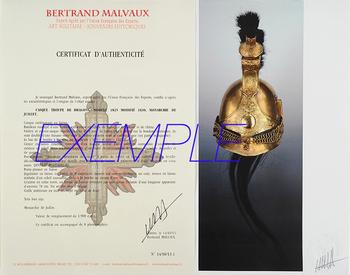
Next update Friday, november 7 at 13:30 PM
FOR ALL PURCHASES, PAYMENT IN MULTIPLE CHECKS POSSIBLE
bertrand.malvaux@wanadoo.fr 06 07 75 74 63
SHIPPING COSTS
Shipping costs are calculated only once per order for one or more items, all shipments are sent via registered mail, as this is the only way to have proof of dispatch and receipt.
For parcels whose value cannot be insured by the Post, shipments are entrusted to DHL or Fedex with real value insured, the service is of high quality but the cost is higher.
RETURN POLICY
Items can be returned within 8 days of receipt. They must be returned by registered mail at the sender's expense, in their original packaging, and in their original condition.
AUTHENTICITY
The selection of items offered on this site allows me to guarantee the authenticity of each piece described here, all items offered are guaranteed to be period and authentic, unless otherwise noted or restricted in the description.
An authenticity certificate of the item including the description published on the site, the period, the sale price, accompanied by one or more color photographs is automatically provided for any item priced over 130 euros. Below this price, each certificate is charged 5 euros.
Only items sold by me are subject to an authenticity certificate, I do not provide any expert reports for items sold by third parties (colleagues or collectors).
FOR ALL PURCHASES, PAYMENT IN MULTIPLE CHECKS POSSIBLE
bertrand.malvaux@wanadoo.fr 06 07 75 74 63
An authenticity certificate of the item including the description published on the site, the period, the sale price, accompanied by one or more color photographs is automatically provided for any item priced over 130 euros. Below this price, each certificate is charged 5 euros.
Only items sold by me are subject to an authenticity certificate, I do not provide any expert reports for items sold by third parties (colleagues or collectors).




